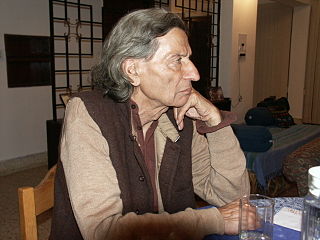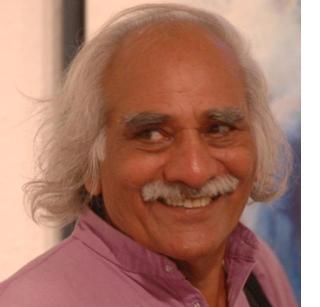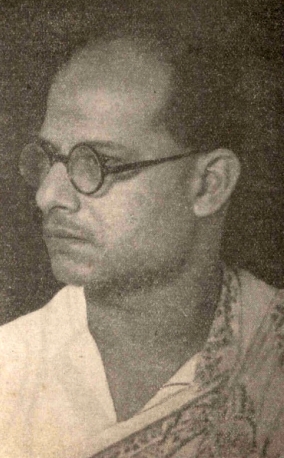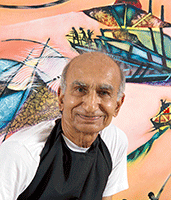Gopi Gajwani (born 1938 in Sind, India) is a painter, photographer, designer, and cartoonist from New Delhi, India. He graduated from the Delhi School of Art in 1959 with a degree in Graphic Designing.
Gopi Gajwani (born 1938 in Sind, India) is a painter, photographer, designer, and cartoonist from New Delhi, India. He graduated from the Delhi School of Art in 1959 with a degree in Graphic Designing.
Gajwani did his graduation in arts from Delhi College of Arts. [1] [2] He was a designer at the American Centre for twenty-nine years, creating posters for plays, films, dances, and workshops, both home-grown and foreign. [3] He contributed cartoons and caricatures to the magazine Span and other publications, besides working as an illustrator. Gajwani designed several coffee table books, some with his own photographs. He also worked as a filmmaker, making experimental short films from 1973 to 2014. [4] His short films, including Time (1973) and The End (1974) were shown in Lalit Kala Akademi's Art in Cinema programme [5]
As a painter, Gajwani had numerous one-man shows at the Shridharani Art Gallery in New Delhi. He also participated in over a hundred group shows in New Delhi and Mumbai, as well as countries outside India. [6]

Ghulam Mohammed Sheikh is a painter, poet and art critic from Gujarat, India. He was awarded the Padma Shri in 1983 and Padmabhushan in 2014 for his contribution in field of art.

The Lalit Kala Akademi or National Academy of Art (LKA) is India's national academy of fine arts. It is an autonomous organisation, established in New Delhi in 1954 by Government of India to promote and propagate understanding of Indian art, in and outside the country.

Sachida Nagdev was an Indian painter based in central Indian town of Bhopal.

Akbar Padamsee was an Indian artist and painter, considered one of the pioneers in modern Indian painting along with S.H. Raza, F.N. Souza and M.F. Husain. Over the years he also worked with various mediums from oil painting, plastic emulsion, water colour, sculpture, printmaking, to computer graphics, and photography. In addition, he worked as a film maker, sculptor, photographer, engraver, and lithographer. Today his paintings are among the most valued by modern Indian artists. His painting Reclining Nude was sold for US$1,426,500 at Sotheby's in New York on 25 March 2011.
Sankho Chaudhuri was an Indian sculptor, and a noted figure in the art scene of India. (Although named Naranarain in due family tradition, he was more widely known by his pet name Sankho). Ram Kinker Baij was his teacher. He began close to cubism and then was influenced by István Beöthy, whom he had met in Paris. His themes have included the female figure and wildlife. He has worked in a wide range of media and produced large-scale reliefs and mobiles.

Ram Gopal Vijayvargiya (1905–2003) was an Indian painter. He was also a poet and a writer.

Keshav Malik was an Indian poet, art and literary critic, arts scholar, and curator. He remained art critic for the Hindustan Times (1960–1972) and The Times of India (1975–2000). He published eighteen volumes of poetry and edited six anthologies of English translations of Indian poetry.

Bikash Bhattacharjee was an Indian painter from Kolkata in West Bengal. Through his paintings, he depicted the life of the average middle-class Bengali – their aspirations, superstitions, hypocrisy and corruption, and even the violence that is endemic to Kolkata. He worked in oils, acrylics, water-colours, conté and collage. In 2003, he was awarded the highest award of Lalit Kala Akademi, India's National Academy of Arts, the Lalit Kala Akademi Fellowship.
Haku Vajubhai Shah was an Indian painter, Gandhian, cultural anthropologist and author on folk and tribal art and culture. His art belonged to the Baroda Group and his works are considered in the line of artists who brought themes of folk or tribal art to Indian art.
Bhabesh Chandra Sanyal commonly known as B. C. Sanyal, the doyen of modernism in Indian art, was an Indian painter and sculptor and an art teacher to three generations of artists. During his lifetime he not just saw the partition of the Indian subcontinent three times, 1905, 1947 and 1971, but also witnessed 20th century Indian art in all its phases. His notable paintings include The flying scarecrow, Cow herd, Despair and Way to peace, which depicts Mahatma Gandhi with a Hindu and a Muslim child.

Nand Katyal, is an Indian artist. His family came to Delhi from Lahore after Partition, and settled there when he was around twelve years of age. His father, Ram Lal Katyal, was himself a painter. Hence Nand was exposed to art materials and the art circle of Lahore at an early age. He studied Fine Art at the Polytechnic in Delhi and worked as an art teacher. In the early 1960s, Katyal joined the American Center and served as the Art Director of Span magazine for many years before turning to art as a freelance practitioner.

Amar Nath Sehgal was a noted Indian modernist sculptor, painter, poet and art educator. He started his career as an engineer in Lahore, and later turned to art. He shifted to Delhi after partition of India in 1947, and in 1950 studied art education from New York University School of Education. Subsequently, became an art educator, teaching at College of Art, Delhi, and in time a noted modern sculptor to his generation. Though he also ventured into painting, drawings and poetry.
Manu Parekh is an Indian painter, known for his several paintings on the city of Varanasi. Reported to be influenced by Rabindranath Tagore and Ram Kinker Baij, Parekh is a recipient of the 1982 Lalit Kala Akademi Award. The Government of India awarded him the fourth highest civilian award of the Padma Shri, in 1991.
Ranbir Singh Bisht (1928–1998) was an Indian painter and the Principal of the College of Fine Arts, Lucknow University. Born in 1928 at Landsdowne in Garhwal, in the present day Indian state of Uttarakhand, he secured Drawing Teacher's Training Certificate and Diploma in Fine Arts from the Government College of Art and Craft, Lucknow. He conducted many solo shows in a number of Indian cities besides a show in New York and participated in group shows in Frankfurt and Tokyo. He was also a participant of the 4th Triennale at New Delhi in 1972.
Biren De (1926–2011) was an Indian painter of modern art, known for his paintings with tantric influences. His paintings were characterized by symmetrical patterns of geometry and the presence of tantric symbols such as mandala, phallus and vagina, reportedly representing masculine and feminine energies of the universe. The Government of India awarded him the fourth highest civilian honour of the Padma Shri in 1992.

Devi Prasad Roy Choudhury was an Indian sculptor, painter and educator. He is well known for his monumental bronze sculptures, especially the Triumph of Labour and the Martyrs' Memorial, and is rated by many as one among the major artists of Indian modern art. He worked in a broad spectrum of mediums including watercolors, expressionist landscapes and commissioned portraits. Large scale sculptures were his particular strength and he made social realism the cornerstone of his art. In addition to painting and sculpting, he also wrestled, played the flute, engaged in hunting and wrote short stories in his spare time.
Gargi Raina is an Indian painter who lives and works in Vadodara, Gujarat.
The GROUP 1890 exhibition was held from 20 to 29 October 1963 at Lalit Kala Akademi, Rabindra Bhavan in New Delhi, India. It was the only exhibition of the artist collective 'group 1890', hence the only existing record of the group's exhibition history in the 1960s contemporary art in India. The group was an entirely male association with 12 members which 'stood passionately and romantically for values of modernism that signaled change'. The members were Raghav Kaneria, M. Reddeppa Naidu, Ambadas Khobragade, Rajesh Mehra, Gulam Mohammed Sheikh, Jagdish Swaminathan, Himmat Shah, Jeram Patel, S. G. Nikam, Eric Bowen, Jyoti Bhatt, and Balkrishna Patel. All of which participated in this inaugural exhibition.

Jayant Parikh is an Indian modern contemporary artist, printmaker, and muralist. He is a student of N. S. Bendre, K. G. Subramanyan and Sankho Chaudhuri. He lives and works in Vadodara, India.

Krishna Shamrao Kulkarni was an Indian painter and an educator. His work was part of the painting event in the art competition at the 1948 Summer Olympics. He was also the founder-president of the avant-garde artist movement, the Delhi Shilpi Chakra.